Drugs for treating cancer
a cancer and drug technology, applied in the field of drugs for treating cancer, can solve the problems of not being able to completely suppress the disease, not being able to achieve antibody therapy, and not being able to achieve complete suppression, so as to achieve synergistic effects of cancer treatmen
- Summary
- Abstract
- Description
- Claims
- Application Information
AI Technical Summary
Benefits of technology
Problems solved by technology
Method used
Image
Examples
example 1
[0160] Examination of an effect provided by using irradiation and an anti-IGF-I monoclonal antibody in combination
[0161] Epidermoid carcinoma cell strain A431 cells (ATCC CRL-1555) were cultured in a 10-centimeter dish. When the cells were 70% confluent, a monoclonal antibody which binds to IGF-I and IGF-II and inhibits activities of IGF-I and IGF-II (hereinafter referred to as anti-IGF monoclonal antibody) KM 1468 which was produced by hybridoma FERM BP-7478 which was prepared in Reference Example 1 was added to the dish so that the final concentration became 100 ng / mL, and irradiation with X rays of 4 Gy was then conducted. At this time, cells in a dish which were not irradiated with X rays were kept as cells without X-ray irradiation. After 30 minutes from the X-ray irradiation, A431 cells were removed from the dish by trypsin treatment to recover A431cells. Further,anti-IGF monoclonal antibody KM, 1468 was added in the beginning of the culturing at a cell density of 10,000 cell...
example 2
[0163] Examination of an effect provided by using an agent having low-molecular weight and an anti-IGF-I monoclonal antibody in combination
[0164] An agent diluted stepwise and anti-IGF monoclonal antibody KM 1468 diluted stepwise were added to a 96-well culture plate at 50 μL / well each. Further, multiple myeloma cell line, LP-1 cells (DSMZ ACC41) were added at 100 μL / well (10,000 cells) each, and the mixture was cultured at 37° C. for 3 days. After the culturing, cell proliferation reagent WST-1 (manufactured by Roche) was added at 20 μL / well. The mixture was cultured at 37° C. for 2 to 3 hours, and OD450 was measured with microplate reader M-SPmax 250 (manufactured by Molecular Devices). The growth inhibitory concentration of the agent was expressed as a relative value when OD450 in which cells were solely added was regarded as 100%. 5 to 70% growth inhibitory concentration (IC5 to IC70) on which the agent or the antibody was added, and IC50 and IC70 on which the agent and the ant...
example 3
[0166] Examination of an administration method in the combined use of a agent having low-molecular weight and an anti-IGF-1 monoclonal antibody
[0167] Multiple myeloma cell line, LP-1 cells (DSMZ ACC41) were seeded in a 96-well culture plate in an amount of 100 μL / well (10,000 cells). Doxorubicin and anti-IGF monoclonal antibody FM 1468 were added, and the mixture was cultured at 37° C. for 3 days. The addition of doxorubicin and KM 1468 to the medium was conducted by the following three methods.
[0168] Method 1: Cells were cultured in 150 μL of a medium in which doxorubicin was solely added on day 1, and in 200 μL of a medium in which doxorubicin and KM 1468 were added on days 2 and 3.
[0169] Method 2: Cells were cultured in 150 μL of a medium in which KM 1468 were solely added on day 1, and in 200 μL of a medium in which doxorubicin and KM 1468 were added on days 2 and 3.
[0170] Method 3: Cells were cultured in a medium comprising doxorubicin and KM 1468 (an amount of the medium i...
PUM
| Property | Measurement | Unit |
|---|---|---|
| Time | aaaaa | aaaaa |
| Molecular weight | aaaaa | aaaaa |
Abstract
Description
Claims
Application Information
 Login to View More
Login to View More - R&D
- Intellectual Property
- Life Sciences
- Materials
- Tech Scout
- Unparalleled Data Quality
- Higher Quality Content
- 60% Fewer Hallucinations
Browse by: Latest US Patents, China's latest patents, Technical Efficacy Thesaurus, Application Domain, Technology Topic, Popular Technical Reports.
© 2025 PatSnap. All rights reserved.Legal|Privacy policy|Modern Slavery Act Transparency Statement|Sitemap|About US| Contact US: help@patsnap.com



